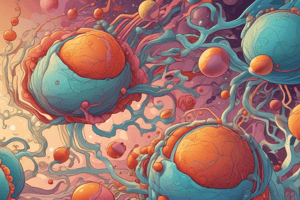Podcast
Questions and Answers
What is the primary function of a ligand?
What is the primary function of a ligand?
- To trigger a response (correct)
- To reduce basal activity
- To regulate gene transcription
- To block a response
Which type of receptor is often associated with steroid hormones and vitamins?
Which type of receptor is often associated with steroid hormones and vitamins?
- Nuclear Receptors (correct)
- Receptor Tyrosine Kinases (RTKs)
- G-Protein Coupled Receptors (GPCRs)
- Cell Surface Receptors
What determines the intensity of a response triggered by a ligand-receptor interaction?
What determines the intensity of a response triggered by a ligand-receptor interaction?
- Efficacy
- Affinity (correct)
- Specificity
- All of the above
What is the purpose of a negative feedback loop in signaling pathways?
What is the purpose of a negative feedback loop in signaling pathways?
What type of ligand is an example of a hormone or neurotransmitter?
What type of ligand is an example of a hormone or neurotransmitter?
What is the goal of drug development in regards to ligand-receptor interactions?
What is the goal of drug development in regards to ligand-receptor interactions?
Flashcards are hidden until you start studying
Study Notes
Ligands and Receptors
Definition:
- A ligand is a molecule that binds to a specific receptor, triggering a response or signal.
- A receptor is a protein or molecule that binds to a specific ligand, initiating a cellular response.
Types of Ligands:
- Agonists: bind to receptors, triggering a response (e.g., hormones, neurotransmitters)
- Antagonists: bind to receptors, blocking the response (e.g., drug blockers)
- Inverse Agonists: bind to receptors, reducing basal activity (e.g., some antidepressants)
Receptor Types:
- Cell Surface Receptors:
- G-Protein Coupled Receptors (GPCRs): activate G-proteins, triggering signaling cascades
- Receptor Tyrosine Kinases (RTKs): phosphorylate and activate downstream targets
- Nuclear Receptors: regulate gene transcription, often responding to steroid hormones and vitamins
Ligand-Receptor Interaction:
- Specificity: ligands bind specifically to their cognate receptors, ensuring precise cellular responses
- Affinity: the strength of ligand-receptor binding, influencing the response intensity
- Efficacy: the maximum response achievable by a ligand-receptor interaction
Signaling Pathways:
- Signaling Cascades: stepwise activation of downstream effectors, amplifying the initial signal
- Feedback Loops: negative feedback mechanisms that regulate signaling intensity and duration
Clinical Relevance:
- Disease Treatment: targeting specific ligand-receptor interactions for therapeutic benefits (e.g., insulin for diabetes)
- Drug Development: designing ligands that selectively interact with specific receptors to treat diseases
Ligands and Receptors
- Ligand: a molecule that binds to a specific receptor, triggering a response or signal.
- Receptor: a protein or molecule that binds to a specific ligand, initiating a cellular response.
Types of Ligands
- Agonists: bind to receptors, triggering a response (e.g., hormones, neurotransmitters).
- Antagonists: bind to receptors, blocking the response (e.g., drug blockers).
- Inverse Agonists: bind to receptors, reducing basal activity (e.g., some antidepressants).
Receptor Types
- Cell Surface Receptors:
- G-Protein Coupled Receptors (GPCRs): activate G-proteins, triggering signaling cascades.
- Receptor Tyrosine Kinases (RTKs): phosphorylate and activate downstream targets.
- Nuclear Receptors: regulate gene transcription, often responding to steroid hormones and vitamins.
Ligand-Receptor Interaction
- Specificity: ligands bind specifically to their cognate receptors, ensuring precise cellular responses.
- Affinity: the strength of ligand-receptor binding, influencing the response intensity.
- Efficacy: the maximum response achievable by a ligand-receptor interaction.
Signaling Pathways
- Signaling Cascades: stepwise activation of downstream effectors, amplifying the initial signal.
- Feedback Loops: negative feedback mechanisms that regulate signaling intensity and duration.
Clinical Relevance
- Disease Treatment: targeting specific ligand-receptor interactions for therapeutic benefits (e.g., insulin for diabetes).
- Drug Development: designing ligands that selectively interact with specific receptors to treat diseases.
Studying That Suits You
Use AI to generate personalized quizzes and flashcards to suit your learning preferences.



